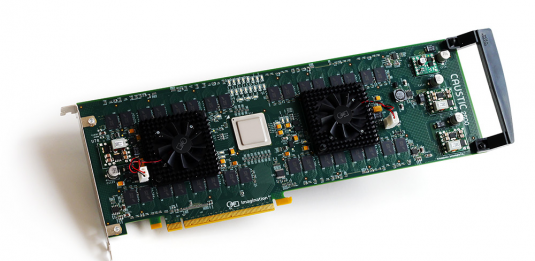Caustic by Imagination was showing off its new accelerator board. But Nvidia’s latest high-end GPU might be as fast.
Direct-to-final-render viewing, from the earliest design stages to the final product, definitely improves the creative workflow for individual artists, teams, and even their clients—but how do you do it?
Being able to model and ray trace simultaneously lets an artist see true refractions and reflections as he or she designs. Caustic says due to their fast, almost real-time ray-tracing, the quality, speed, and fidelity free up artists to iterate at will, making product design perfectly interactive. But it’s not just the ray-tracing hardware—you need special software too.

The Visualizer
Caustic Visualizer is Imagination’s plug-in board, allowing artists to replace the rasterized viewport in Autodesk Maya 2012–2014 and 3ds Max 2012–2014 with a ray-traced viewport. Visualizer viewports provide global illumination, reflections, refractions, and shadows.
Artists working in Maya get a new rendering workflow with an always-on photorealistic viewport. Visualizer users get ray-traced visual feedback while making scene changes in geometry, animation, and lighting and rendering parameters using Maya’s standard toolsets—including Mental Ray lights and materials.
Visualizer’s path-tracing renderer produces both interactive or final-file photorealistic images and animations. Higher fidelity enables artists to identify and resolve potential problems from the earliest stages of modeling, minimizing the need for time-consuming preview renders and radically streamlining the look development process. Caustic says artists can render frame sequences with Visualizer with the confidence that what they see in the viewport is what they’ll get in their final frame.
Our take
Nvidia’s new K6000 GPU ($3,500 from PNY, available soon) also does fast ray tracing. It looks about as fast as the Caustic boards. It’s more money, but you also get accelerated real-time shading. So what Caustic is doing is not unique. But, using the GPU for ray tracing is not the same as using a dedicated co-processor. In most cases, it’s not going to be as fast. The Caustic two-chip R2500 add-in board (AIB) is $1,500, and the single chip version R2100 is $800—but you still need a GPU AIB. The R2100/2500s are co-processors. So if you used an average OpenGL-qualified workstation AIB, like a Quadro R5000, you’d pay another $1,000 (assuming you were building a new system). It is reasonable to assume you would already have an AIB and were just investing in ray-tracing acceleration. (You can get an AMD FirePro V7900 2-GB AIB for $700.)
There is no public ray-tracing benchmark, so it’s an individual’s test. In tests we’ve seen Caustic run, they were much faster. Obviously, Caustic would have to be faster to justify the additional cost.
Having said all that, Caustic plans to do ray tracing in mobile systems using the GPU.





